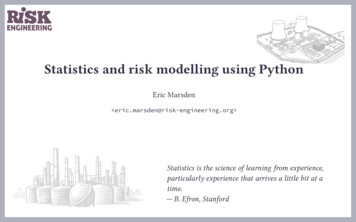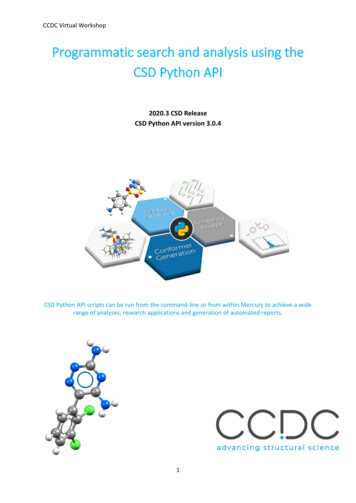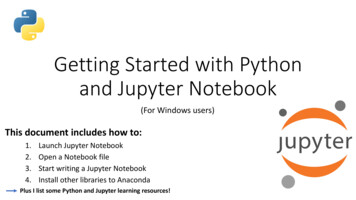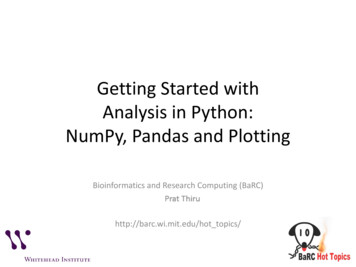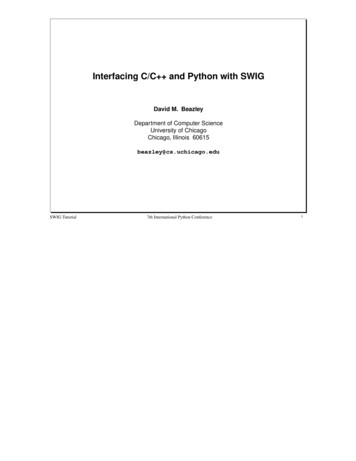
Transcription
Interfacing C/C and Python with SWIGDavid M. BeazleyDepartment of Computer ScienceUniversity of ChicagoChicago, Illinois 60615beazley@cs.uchicago.eduSWIG Tutorial7th International Python Conference1
PrerequisitesC/C programming You’ve written a C program. You’ve written a Makefile. You know how to use the compiler and linker.Python programming You’ve heard of Python. You’ve hopefully written a few Python programs.Optional, but useful Some knowledge of the Python C API. C programming experience.Intended Audience C/C application developers interested in making better programs Developers who are adding Python to “legacy” C/C code. Systems integration (Python as a glue language).SWIG TutorialNotes7th International Python Conference2
C/C ProgrammingThe good High performance. Low-level systems programming. Available everywhere and reasonably well standardizedThe bad The compile/debug/nap development cycle. Difficulty of extending and modifying. Non-interactive.The ugly Writing user-interfaces. Writing graphical user-interfaces (worse). High level programming. Systems integration (gluing components together).SWIG TutorialNotes7th International Python Conference3
What Python Brings to C/C An interpreted high-level programming environment Flexibility. Interactivity. Scripting. Debugging. Testing Rapid prototyping.Component gluing A common interface can be provided to different C/C libraries. C/C libraries become Python modules. Dynamic loading (use only what you need when you need it).The best of both worlds Performance of C The power of Python.SWIG TutorialNotes7th International Python Conference4
Points to Ponder“Surely the most powerful stroke for software productivity, reliability, and simplicityhas been the progressive use of high-level languages for programming. Mostobservers credit that development with at least a factor of 5 in productivity, andwith concomitant gains in reliability, simplicity, and comprehensibility.”--- Frederick Brooks“The best performance improvement is the transition from the nonworking state tothe working state.”--- John Ousterhout“Less than 10% of the code has to do with the ostensible purpose of the system;the rest deals with input-output, data validation, data structure maintenance, andother housekeeping”--- Mary Shaw“Don’t keep doing what doesn’t work”--- AnonymousSWIG TutorialNotes7th International Python Conference5
PreviewBuilding Python Modules What is an extension module and how do you build one?SWIG Automated construction of Python extension modules. Building Python interfaces to C libraries. Managing Objects. Using library files. Customization and advanced features.Practical Isses Working with shared libraries. C/C coding strategies Potential incompatibilities and problems. Tips and tricks.SWIG TutorialNotes7th International Python Conference6
Python Extension BuildingSWIG Tutorial7th International Python Conference7
Extending and Embedding PythonThere are two basic methods for integrating C/C with Python Extension writing.Python access to C/C . EmbeddingC/C access to the Python interpreter.PythonExtendingEmbeddingC/C We are primarily concerned with “extension writing”.SWIG TutorialNotes7th International Python Conference8
Writing Wrapper Functions“wrapper” functions are needed to access C/C Wrappers serve as a glue layer between languages. Need to convert function arguments from Python to C. Need to return results in a Python-friendly form.C FunctionWrapperint fact(int n) {if (n 1) return 1;else return n*fact(n-1);}PyObject *wrap fact(PyObject *self, PyObject *args) {intn, result;if (!PyArg ParseTuple(args,”i:fact”,&n))return NULL;result fact(n);return Py BuildValue(“i”,result);}SWIG Tutorial7th International Python ConferenceNotesThe conversion of data between Python and C is performed using two functions :int PyArg ParseTuple(PyObject *args, char *format, .)PyObject *Py BuildValue(char *format, .)For each function, the format string contains conversion codes according to the following table :silhcfdO(items) items char *intlong intshort intcharfloatdoublePyObject *A tupleOptional argumentsThese functions are used as follows :PyArg ParseTuple(args,”iid”,&a,&b,&c);PyArg ParseTuple(args,”s s”,&a,&b);Py BuildValue(“d”,value);Py BuildValue(“(ddd)”,a,b,c);////////Parse an int,int,doubleParse a string and an optional stringCreate a doubleCreate a 3-item tuple of doublesRefer to the Python extending and embedding guide for more details.9
Module InitializationAll extension modules need to register wrappers with Python An initialization function is called whenever you import an extension module. The initialization function registers new methods with the Python interpreter.A simple initialization function :static PyMethodDef exampleMethods[] {{ "fact", wrap fact, 1 },{ NULL, NULL }};void initexample() {PyObject *m;m Py InitModule("example", exampleMethods);}SWIG Tutorial7th International Python Conference10NotesWhen using C , the initialization function must be given C linkage. For example :extern “C” void initexample() {.}On some machines, particularly Windows, it may be necessary to explicitly export the initialization functions. For example,#if defined( WIN32 )#if defined( MSC VER)#define EXPORT(a,b) declspec(dllexport) a b#else#if defined( BORLANDC )#define EXPORT(a,b) a export b#else#define EXPORT(a,b) a b#endif#endif#else#define EXPORT(a,b) a b#endif.EXPORT(void, initexample) {.}
A Complete Extension Example#include Python.h WrapperFunctionsPyObject *wrap fact(PyObject *self, PyObject *args) {intn, result;if (!PyArg ParseTuple(args,”i:fact”,&n))return NULL;result fact(n);return Py BuildValue(“i”,result);}MethodsTablestatic PyMethodDef exampleMethods[] {{ "fact", wrap fact, 1 },{ NULL, NULL }};InitializationFunctionSWIG Tutorialvoid initexample() {PyObject *m;m Py InitModule("example", exampleMethods);}7th International Python ConferenceNotesA real extension module might contain dozens or even hundreds of wrapper functions, but the idea is the same.11
Compiling A Python ExtensionThere are two methods Dynamic Loading. Static linking.Dynamic Loading The extension module is compiled into a shared library or DLL. When you type ‘import’, Python loads and initializes your module on the fly.Static Linking The extension module is compiled into the Python core. The module will become a new “built-in” module. Typing ‘import’ simply initializes the module.Given the choice, you should try to use dynamic loading It’s usually easier. It’s surprisingly powerful if used right.SWIG Tutorial7th International Python Conference12NotesMost modern operating systems support shared libraries and dynamic loading. To find out more details, view the man-pages forthe linker and/or C compiler.
Dynamic LoadingUnfortunately, the build process varies on every machine Solariscc -c -I/usr/local/include/python1.5 \-I/usr/local/lib/python1.5/config \example.c wrapper.cld -G example.o wrapper.o -o examplemodule.so Linuxgcc -fpic -c -I/usr/local/include/python1.5 \-I/usr/local/lib/python1.5/config \example.c wrapper.cgcc -shared example.o wrapper.o -o examplemodule.so Irixcc -c -I/usr/local/include/python1.5 \-I/usr/local/lib/python1.5/config \example.c wrapper.cld -shared example.o wrapper.o -o examplemodule.soSWIG TutorialNotes7th International Python Conference13
Dynamic Loading (cont.) Windows 95/NT (MSVC )Select a DLL project from the AppWizard in Developer Studio. Make sure you addthe following directories to the include pathpython-1.5python-1.5\Includepython-1.5\PcLink against the Python library. For example :python-1.5\vc40\python15.libAlso. If your module is named ‘example’, make sure you compile it into a file named‘example.so’ or ‘examplemodule.so’. You may need to modify the extension to compile properly on all different platforms. Not all code can be easily compiled into a shared library (more on that later).SWIG TutorialNotes7th International Python Conference14
Static LinkingHow it works You compile the extension module and link it with the rest of Python to form a newPython executable.C ExtensionsPythonCustom PythonWhen would you use it? When running Python on esoteric machines that don’t have shared libraries. When building extensions that can’t be linked into a shared library. If you had a commonly used extension that you wanted to add to the Python core.SWIG TutorialNotes7th International Python Conference15
Modifying ‘Setup’ to Add an ExtensionTo add a new extension module to the Python executable1. Locate the ‘Modules’ directory in the Python source directory.2. Edit the file ‘Setup’ by adding a line such as the following :example example.c wrapper.cModule nameC source files3. Execute the script “makesetup”4. Type ‘make’ to rebuild the Python executable.Disadvantages Requires the Python source May be difficult if you didn’t install Python yourself. Somewhat cumbersome during module development and debugging.SWIG TutorialNotes7th International Python Conference16
Rebuilding Python by HandTo manually relink the Python executable (if necessary) :PREFIXEXEC PREFIX /usr/local /usr/localCC ccPYINCLUDEPYLIBSMAINOBJPYTHONPATH -I (PREFIX)/include/python1.5 -I (EXEC PREFIX)/lib/python1.5/config -L (EXEC PREFIX)/lib/python1.5/config \-lModules -lPython -lObjects -lParser -ldl -lm (EXEC PREFIX)/lib/python1.5/config/getpath.c \ (EXEC PREFIX)/lib/python1.5/config/config.c (EXEC PREFIX)/lib/python1.5/config/main.o .: (PREFIX)/lib/python1.5: (PREFIX)/lib/python1.5/sharedmodulesOBJS # Additional object files hereSYSLIBSPYSRCSall: (CC) (PYINCLUDE) -DPYTHONPATH '" (PYTHONPATH)"' -DPREFIX '" (PREFIX)"' \-DEXEC PREFIX '" (EXEC PREFIX)"' -DHAVE CONFIG H (PYSRCS) \ (OBJS) (MAINOBJ) (PYLIBS) (SYSLIBS) -o pythonFortunately, there is a somewhat easier way (stay tuned).SWIG Tutorial7th International Python Conference17NotesIf performing a by-hand build of Python, the file ‘config.c’ contains information about the modules contained in the “Setup”script. If needed, you can copy config.c and modify it as needed to add your own modules.The book “Internet Programming with Python”, by Watters, van Rossum, and Ahlstrom contains more information aboutrebuilding Python and the process of adding modules in this manner.
Using The ModuleThis is the easy part :Python 1.5.1 (#1, May 6 1998) [GCC 2.7.3]Copyright 1991-1995 Stichting Mathematisch Centrum,Amsterdam import example example.fact(4)24 Summary : To write a module, you need to write some wrapper functions. To build a module, the wrapper code must be compiled into a shared library or staticlylinked into the Python executable (this is the tricky part). Using the module is easy. If all else fails, read the manual (honestly!).SWIG TutorialNotes7th International Python Conference18
Wrapping a C ApplicationThe process Write a Python wrapper function for every C function you want to access. Create Python versions of C constants (not discussed). Provide access to C variables, structures, and classes as needed. Write an initialization function. Compile the whole mess into a Python module.The problem Imagine doing this for a huge library containing hundreds of functions. Writing wrappers is extremely tedious and error-prone. Consider the problems of frequently changing C code. Aren’t there better things to be working on?SWIG TutorialNotes7th International Python Conference19
Extension Building ToolsStub Generators (e.g. Modulator) Generate wrapper function stubs and provide additional support code. You are responsible for filling in the missing pieces and making the module work.Automated tools (e.g. SWIG, GRAD, bgen, etc.) Automatically generate Python interfaces from an interface specification. May parse C header files or a specialized interface definition language (IDL). Easy to use, but somewhat less flexible than hand-written extensions.Distributed Objects (e.g. ILU) Concerned with sharing data and methods between languages Distributed systems, CORBA, COM, ILU, etc.Extensions to Python itself (e.g. Extension classes, MESS, etc.) Aimed at providing a high-level C/C API to Python. Allow for powerful creation of new Python types, providing integration with C , etc.SWIG Tutorial7th International Python Conference20Notes :The Python contributed archives contain a wide variety of programming tools. There is no right or wrong way to extend Python-it depends on what kind of problem you’re trying to solve. In some cases, you may want to use many of the tools together.
SWIGSWIG Tutorial7th International Python Conference21
An Introduction to SWIGSWIG (Simplified Wrapper and Interface Generator) A compiler that turns ANSI C/C declarations into scripting language interfaces. Completely automated (produces a fully working Python extension module). Language neutral. SWIG can also target Tcl, Perl, Guile, MATLAB, etc. Attempts to eliminate the tedium of writing extension modules.ANSI C/C declarationsSWIGPythonSWIG TutorialNotesPerl5Tcl/TkGuile7th International Python Conference.?22
SWIG FeaturesCore features Parsing of common ANSI C/C declarations. Support for C structures and C classes. Comes with a library of useful stuff. A wide variety of customization options. Language independence (works with Tcl, Perl, MATLAB, and others). Extensive documentation.The SWIG philosophy There’s more than one way to do it (a.k.a. the Perl philosophy) Provide a useful set of primitives. Keep it simple, but allow for special cases. Allow people to shoot themselves in the foot (if they want to).SWIG TutorialNotes7th International Python Conference23
A Simple SWIG ExampleSome C code/* example.c */double Foo 7.5;int fact(int n) {if (n 1) return 1;else return n*fact(n-1);}A SWIG interface fileModule NameHeadersC declarationsSWIG Tutorial// example.i%module example%{#include "headers.h"%}int fact(int n);double Foo;#define SPAM 427th International Python Conference24NotesScripting interfaces are typically defined in terms of a special “interface file.” This file contains the ANSI C declarations ofthings you want to access, but also contains SWIG directives (which are always preceded by ’%’). The %module directivespecifies the name of the Python extension module. Any code enclosed by %{ . %} is copied verbatim into the wrapper codegenerated by SWIG (this is usually used to include header files and other supporting code).
A Simple SWIG Example (cont.)Building a Python Interface% swig -python example.iGenerating wrappers for Python% cc -c example.c example wrap.c \-I/usr/local/include/python1.5 \-I/usr/local/lib/python1.5/config% ld -shared example.o example wrap.o -o examplemodule.so SWIG produces a file ‘example wrap.c’ that is compiled into a Python module. The name of the module and the shared library should match.Using the modulePython 1.5 (#1, May 06 1998) [GCC 2.7.3]Copyright 1991-1995 Stichting Mathematisch Centrum,Amsterdam import example example.fact(4)24 print example.cvar.Foo7.5 print example.SPAM42SWIG Tutorial7th International Python Conference25NotesThe process of building a shared library differs on every machine. Refer to earlier slides for more details.All global variables are accessed through a special object ‘cvar’ (for reasons explained shortly).Troubleshooting tips If you get the following error, it usually means that the name of your module and the name of the shared library don’t match. import exampleTraceback (innermost last):File " stdin ", line 1, in ?ImportError: dynamic module does not define init function If you get the following error, Python may not be able to find your module. import exampleTraceback (innermost last):File " stdin ", line 1, in ?ImportError: No module named example To fix this problem, you may need to modify Python’s path as follows import sys sys.path.append("/your/module/path") import example The following error usually means your forgot to link everything or there is a missing library. import examplepython: can't resolve symbol 'foo'Traceback (innermost last):File " stdin ", line 1, in ?ImportError: Unable to resolve symbol
What SWIG DoesBasic C declarations C functions become Python functions (or commands). C global variables become attributes of a special Python object ’cvar’. C constants become Python variables.Datatypes C built-in datatypes are mapped into the closest Python equivalent. int, long, short --- Python integers. float, double --- Python floats char, char * --- Python strings. void --- None long long, long double --- Currently unsupportedSWIG tries to create an interface that is a natural extension of theunderlying C code.SWIG Tutorial7th International Python Conference26Notes Python integers are represented as ’long’ values. All integers will be cast to and from type long whenconverting between C and Python. Python floats are represented as ’double’ values. Single precision floating point values will be cast to typedouble when converting between the languages. long long and long double are unsupported due to the fact that they can not be accurately representedin Python (the values would be truncated).
More on Global VariablesWhy does SWIG access global variables through ’cvar’?"Assignment" in Python Variable "assignment" in Python is really just a renaming operation. Variables are references to objects. [1,a [1,2,3]b ab[1] -10print a-10, 3] A C global variable is not a reference to an object, it is an object. To make a long story short, assignment in Python has a meaning that doesn’ttranslate to assignment of C global variables.Assignment through an object C global variables are mapped into the attributes of a special Python object. Giving a new value to an attribute changes the value of the C global variable. By default, the name of this object is ’cvar’, but the name can be changed.SWIG Tutorial277th International Python ConferenceNotesEach SWIG generated module has a special object that is used for accessing C global variables present in the interface. Bydefault the name of this object is ’cvar’ which is short for ’C variables.’ If necessary, the name can be changed using the-globals option when running SWIG. For example :% swig -python -globals myvar example.ichanges the name to ’myvar’ instead.If a SWIG module contains no global variables, the ’cvar’ variable will not be created. Some care is also in order for usingmultiple SWIG generated modules--if you use the Python ’from module *’ directive, you will get a namespace collision onthe value of ’cvar’ (unless you explicitly changed its name as described above).The assignment model in Python takes some getting used to.Here’s a pictorial representation of what’s happening.a 4a4b aa4ba 7a7b4
More on ConstantsThe following declarations are turned into Python variables #define const enumExamples :#define ICONST5#define FCONST3.14159#define SCONST"hello world"enum boolean {NO 0, YES 1};enum months {JAN, FEB, MAR, APR, MAY, JUN, JUL, AUG, SEP, OCT, NOV, DEC };const double PI 3.141592654;#define MODE 0x04 0x08 0x40 The type of a constant is inferred from syntax (unless given explicitly) Constant expressions are allowed. Values must be defined. For example, ’#define FOO BAR’ does not result in aconstant unless BAR has already been defined elsewhere.SWIG Tutorial7th International Python Conference28Notes#define is also used by the SWIG preprocessor to define macros and symbols. SWIG only creates a constant if a #definedirective looks like a constant. For example, the following directives would create constants#define#define#define#defineREAD MODEHAVE ALLOCAFOOBARVALUE118.299934*FOOBARThe following declarations would not result in constants#define USE PROTOTYPES#define ANSI ARGS (a)#define FOOBARa// No value given// A macro// BAR is undefined
PointersPointer management is critical! Arrays Objects Most C programs have tons of pointers floating around.The SWIG type-checked pointer model C pointers are handled as opaque objects. Encoded with type-information that is used to perform run-time checking. Pointers to virtually any C/C object can be managed by SWIG.Advantages of the pointer model Conceptually simple. Avoids data representation issues (it’s not necessary to marshal objects between aPython and C representation). Efficient (works with large C objects and is fast). It is a good match for most C programs.SWIG Tutorial7th International Python Conference29NotesThe pointer model allows you to pass pointers to C objects around inside Python scripts, pass pointers to other C functions, and soforth. In many cases this can be done without ever knowing the underlying structure of an object or having to convert C datastructures into Python data structures.An exception to the rule : SWIG does not support pointers to C member functions. This is because such pointers can not beproperly cast to a pointer of type ’void *’ (the type that SWIG uses internally).
Pointer Example%module exampleFILEintunsignedunsigned*fopen(char *filename, char *mode);fclose(FILE *f);fread(void *ptr, unsigned size, unsigned nobj, FILE *);fwrite(void *ptr, unsigned size, unsigned nobj, FILE *);// A memory allocation functionsvoid*malloc(unsigned nbytes);voidfree(void *);import exampledef filecopy(source,target):f1 example.fopen(source,"r")f2 example.fopen(target,"w")buffer example.malloc(8192)nbytes example.fread(buffer,1,8192,f1)while nbytes 0:example.fwrite(buffer,1,nbytes,f2)nbytes xample.fclose(f2)example.free(buffer)SWIG Tutorial7th International Python Conference30Notes You can use C pointers in exactly the same manner as in C. In the example, we didn’t need to know what a FILE was to use it (SWIG does not need to know anything about the data apointer actually points to). Like C, you have the power to shoot yourself in the foot. SWIG does nothing to prevent memory leaks, double freeing ofmemory, passing of NULL pointers, or preventing address violations.
Pointer Encoding and Type CheckingPointer representation Currently represented by Python strings with an address and type-signature. f example.fopen("test","r") print ff8e40a8 FILE p buffer example.malloc(8192) print buffer1000afe0 void p Pointers are opaque so the precise Python representation doesn’t matter much.Type errors result in Python exceptions example.fclose(buffer)Traceback (innermost last):File " stdin ", line 1, in ?TypeError: Type error in argument 1 of fclose. Expected FILE p. Type-checking prevents most of the common errors. Has proven to be extremely reliable in practice.SWIG Tutorial7th International Python Conference31Notes The NULL pointer is represented by the string "NULL" Python has a special object "CObject" that can be used to hold pointer values. SWIG does not use this object because it doesnot currently support type-signatures. Run-time type-checking is essential for reliable operation because the dynamic nature of Python effectively bypasses all typechecking that would have been performed by the C compiler. The SWIG run-time checker makes up for much of this. Future versions of SWIG are likely to change the current pointer representation of strings to an entirely new Python type. Thischange should not substantially affect the use of SWIG however.
Array HandlingArrays are pointers Same model used in C (the "value" of an array is a pointer to the first element). Multidimensional arrays are supported. There is no difference between an ordinary pointer and an array. However, SWIG does not perform bounds or size checking. C arrays are not the same as Python lists or tuples!%module exampledouble *create array(int size);voidspam(double a[10][10][10]); d create array(1000) print d100f800 double p spam(d) SWIG Tutorial7th International Python Conference32NotesPointers and arrays are more-or-less interchangable in SWIG. However, no checks are made to insure that arrays are of the propersize or even initialized properly (if not, you’ll probably get a segmentation fault).It may be useful to re-read the section on arrays in your favorite C programming book---there are subtle differences betweenarrays and pointers (unfortunately, they are easy to overlook or forget). For example, a pointer of type "double ***" can beaccessed as a three-dimensional array, but is not represented in the same way as a three-dimensional array.Effective use of arrays may require the use of accessor-functions to access individual members (this is described later).If you plan to do alot of array manipulation, you may want to check out the Numeric Python extension.
Complex ObjectsSWIG manipulates all "complex" objects by reference The definition of an object is not required. Pointers to objects can be freely manipulated. Any "unrecognized" datatype is treated as if it were a complex object.Examples :double dot product(Vector *a, Vector *b);FILE *fopen(char *, char *);Matrix *mat mul(Matrix *a, Matrix *b);SWIG Tutorial7th International Python Conference33NotesWhenever SWIG encounters an unknown datatype, it assumes that it is a derived datatype and manipulates it by reference.Unlike the C compiler, SWIG will never generate an error about undefined datatypes. While this may sound strange, it makes itpossible for SWIG to build interfaces with a minimal amount of additional information. For example, if SWIG sees a datatype’Matrix *’, it’s obviously a pointer to something (from the syntax). From SWIG’s perspective, it doesn’t really matter what thepointer is actually pointing to--that is, SWIG doesn’t need the definition of Matrix.
Passing Objects by ValueWhat if a program passes complex objects by value?double dot product(Vector a, Vector b); SWIG converts pass-by-value arguments into pointers and creates a wrapperequivalent to the following :double wrap dot product(Vector *a, Vector *b) {return dot product(*a,*b);} This transforms all pass-by-value arguments into pass-by reference.Is this safe? Works fine with C programs. Seems to work fine with C if you aren’t being too clever.SWIG Tutorial7th International Python Conference34NotesTrying to implement pass-by-value directly would be extremely difficult---we would be faced with the problem of trying to find aPython representation of C objects (a problem we would rather avoid).Make sure you tell SWIG about all typedefs. For example,Real spam(Real a);// Real is unknown.Use as a pointertypedef double Real;Real spam(Real a);// Ah. Real is just a ’double’.versus
Return by ValueReturn by value is more difficult.Vector cross product(Vector a, Vector b); What are we supposed to do with the return value? Can’t generate a Python representation of it (well, not easily), can’t throw it away. SWIG is forced to perform a memory allocation and return a pointer.Vector *wrap cross product(Vector *a, Vector *b) {Vector *result (Vector *) malloc(sizeof(Vector));*result cross product(*a,*b);return result;}Isn’t this a huge memory leak? Yes. It is the user’s responsibility to free the memory used by the result. Better to allow such a function (with a leak), than not at all.SWIG Tutorial7th International Python ConferenceNotesWhen SWIG is processing C libraries, it uses the default copy constructor instead. For example :Vector *wrap cross product(Vector *a, Vector *b) {Vector *result new Vector(cross product(*a,*b));return result;}35
Renaming and RestrictingRenaming declarations The %name directive can be used to change the name of the Python command.%name(output) void print(); Often used to resolve namespace conflicts between C and Python.Creating read-only variables The %readonly and %readwrite directives can be used to change accesspermissions to variables.double foo;%readonlydouble bar;double spam;%readwrite// A global variable (read/write)// A global variable (read only)// (read only) Read-only mode stays in effect until it is explicitly disabled.SWIG TutorialNotes7th International Python Conference36
Code InsertionThe structure of SWIG’s outputHeaderWrapper functionsInitialization function/* This file was created by SWIG */#include Python.h PyObject * wrap foo(PyObject *, .) {.}.void initexample() {.}Four directives are available for inserting code %{ . %} inserts code into the header section. %wrapper %{ . %} inserts code into the wrapper section. %init %{ . %} inserts code into the initialization function. %inline %{ . %} inserts code into the header section and "wraps" it.SWIG Tutorial7th International Python Conference37NotesThese directives insert code verbatim into the output file. This is usually necessary.The syntax of these directives is loosely derived from YACC parser generators which also use %{,%} to insert supporting code.Almost all SWIG applications need to insert supporting code into the wrapper output.
Code Insertion ExamplesIncluding the proper header files (extremely common)%module opengl%{#include GL/gl.h #include GL/glu.h %}// Now list declarationsModule specific initialization%module matlab.// Initialize the module when imported.%init %{eng engOpen("matlab42");%}SWIG Tutorial7th International Python Conference38NotesInclusion of header files and module specific initialization are two of the most common uses for the code insertion directives.
Helper FunctionsSometimes it is useful to write supporting functions Creation and destruction of objects. Providing access to arrays. Accessing internal pieces of data structures.%module darray%inline %{double *new darray(int size) {return (double *) malloc(size*sizeof(double));}double darray get(double *a, int
SWIG Tutorial 7th International Python Conference What Python Brings to C/C An interpreted high-level programming environment Flexibility. Interactivity. Scripting. Debugging. Testing Rapid prototyping. Component gluing A common interface can be provided to different C/C


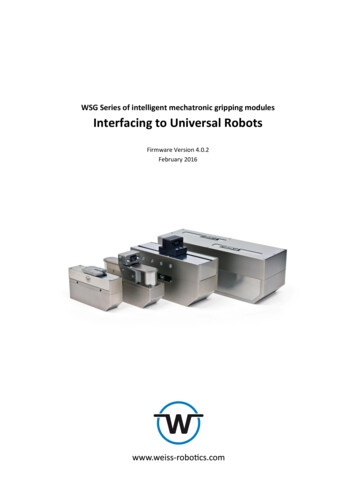


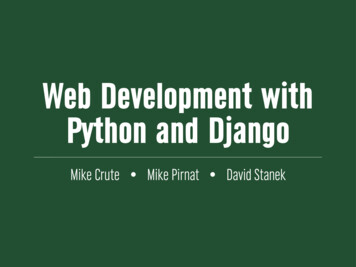
![Fluent Python : [clear, concise, and effective programming]](/img/1/799981060.jpg)
